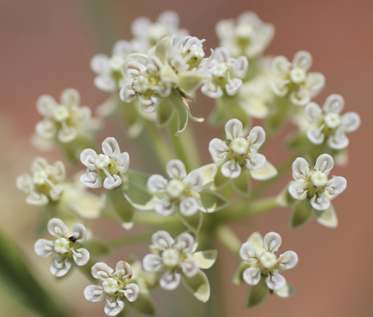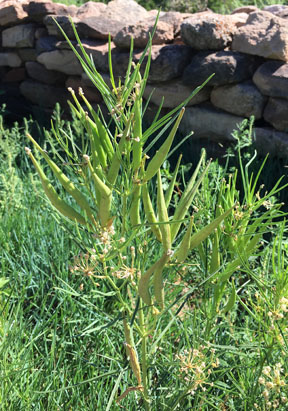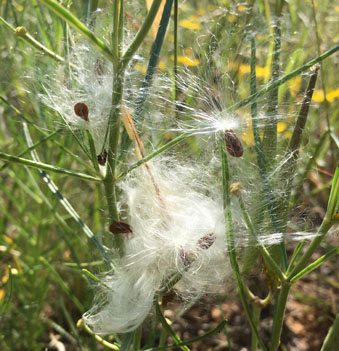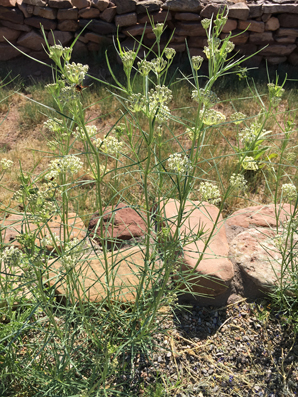
Location
On trail close to #3 (N35D33'04.841 X W105D41'21.431)
Flowers first observed: 6/21/17
The Plant w/Flowers
The Flowers

 |
 |
Seed Pods |
Seeds |
Distribution
"Milkweed species grow throughout the United States. Narrow-leaf milkweed occurs on dry ground and sunny spots in valleys and foothills at elevations from 50 to 220 m. The range extends through California to Washington, Utah and Baja California." (USDA)
Description
"Asclepias flowers look like crowns, with the corolla reflexed and hoods elevated above the corolla. In narrow-leaf milkweed, the corolla is reflexed, greenish white, sometimes tinged purple. The hoods are also greenish white. The horns are longer than the hoods. Narrow-leaf milkweed is a glabrous perennial with glabrous to ascending stems. Leaves are in whorls of 3-5, often with axillary clusters of small leaves. The leaf blades are narrowly lanceolate with a tapered base.
Milkweed species are attractive to butterflies, bees, and other insects. Accordingly, this is a wonderful horticultural plant for beautiful floral landscaping that attracts butterflies (particularly Monarchs) and other insects. Monarch butterflies are specific to milkweed plants. This is the only type of plant on which the eggs are laid and the larvae will feed and mature into a chrysalis. Eggs are laid on the underside of young healthy leaves. It is important to have large clumps of milkweeds for the young caterpillars; their response to predation is to drop to the ground and "play possum." They cannot find their way back to the milkweed stems, which they need to survive, unless they are fairly densely spaced.
Monarch, Queen and Viceroy butterflies are Müllerian mimics; all are toxic, and have co-evolved similar warning patterns to avoid predation. Other insects, which utilize milkweed, are the large milkweed bug, common milkweed bug, red milkweed beetle, blue milkweed beetle, and bees." (USDA)
Ethnobotanical Uses
Food:
"Milkweed sap contains a lethal brew of cardenolides (heart poison), which produces vomiting in low doses and death in higher doses." (USDA)
"Pueblo people eat green milkweed pods and uncooked roots from one of the species that forms fleshy tubers underground." (USDA)
"The Yokia Indians of Mendocino County, California, ate the young blossoms of Asclepias fascicularis raw but not in large amounts (Balls 1962). The most common use for these plants, recorded among almost all the tribes throughout California, was to obtain a kind of chewing gum from the sap of Asclepias fascicularis and other milkweed species. The sticky white sap was heated slightly until it became solid, then added to salmon fat or deer grease." (USDA)
Medicine:
None specifically noted for this species.
For Asclepias speciosa:
"Stimulates both urine and perspiration, softens bronchial mucus, dialates bronchials, and encourages expectoration. For a diuretic, Milkweed acts to increase the volume and solids of the urine and will aid in chronic kidney weakness typified by a slight nonspecific ache in the middle back, most noticable in the morning or after drinking alconol. --- Milkweeds contain asclepain, a proteolytic enzyme that gives some rationale to the old folk remedy of rubbing the milky juice on warts.---" (Moore 106-7)
Other Uses:
"Zuni people utilize the silky seed fibers, which are spun on a hand-held wooden spindle, made into yarn, and woven into fabric (especially for dancers)." (USDA)
"Milkweeds supply tough fibers for making cords and ropes, and for weaving a coarse cloth. Milkweeds stems are collected after the stalks dry in late fall to early winter. The dried stalks are split open to release the fibers. Milkweed fibers are sometimes mixed with fibers of Indian hemp, Apocynum cannabinum." (USDA)
Internet Links
